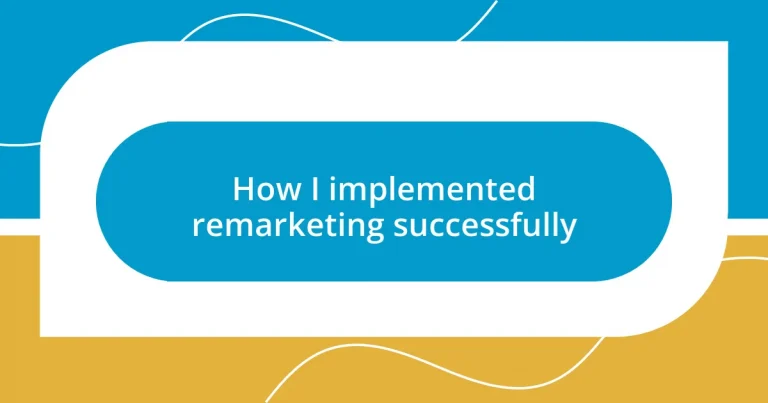Key takeaways:
- Remarketing effectively targets users based on past interactions, enhancing familiarity and boosting conversion rates through tailored messaging.
- Setting clear and specific goals for campaigns, and breaking them down into smaller milestones, facilitates measurable success and targeted engagement.
- Utilizing data-driven strategies, such as dynamic ads and A/B testing, optimizes campaign performance by continually refining messaging and targeting.
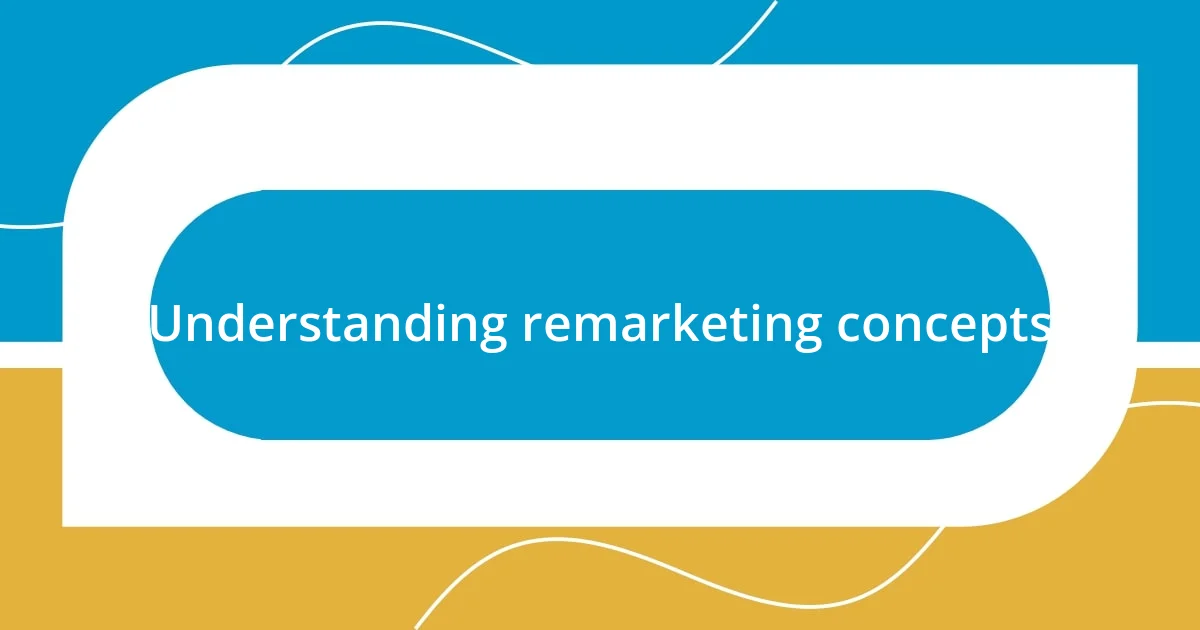
Understanding remarketing concepts
Understanding remarketing concepts requires a deep dive into how it works. At its core, remarketing is about reconnecting with users who’ve previously interacted with your brand. Have you ever wondered why ads for a product you once viewed keep following you around the internet? That’s remarketing in action, and it’s incredibly effective!
In my experience, implementing a remarketing strategy felt like talking to an old friend. I recall a time when I revisited a website, only to find the very shoes I had browsed weeks earlier appearing on my screen again. It was as if the brand knew exactly what I needed, creating a familiar connection that urged me to make a purchase. Emotional triggers like familiarity and relevance can significantly boost conversion rates.
One of the most fascinating aspects of remarketing is its ability to segment audiences based on their behavior. Have you ever clicked on an ad and thought, “This is exactly what I was looking for”? That’s the power of tailored messaging. By categorizing users based on their actions, businesses can deliver personalized ads that resonate more deeply, making the user feel understood and prompted to act.
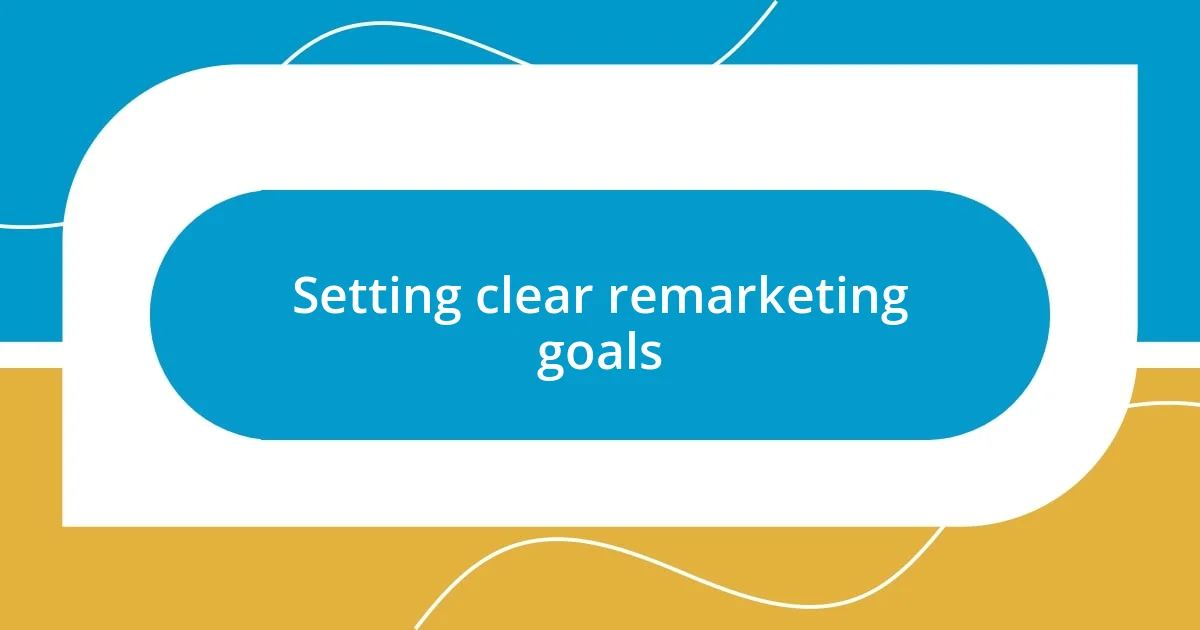
Setting clear remarketing goals
Setting clear goals for your remarketing campaign is crucial for success. When I first started, I quickly realized that vague objectives lead to scattered efforts and confused messaging. For example, simply aiming to increase sales without defining how much or which products to focus on left me feeling directionless. Ultimately, I learned that specificity in setting goals not only clarifies the path but also makes measuring success far easier.
As I refined my approach, I discovered that breaking down larger goals into smaller, actionable milestones created a sense of achievement along the way. Instead of just wanting to boost website visits, I focused on increasing return visits from users who had previously engaged with my content. This targeted strategy resulted in significant increases in my audience engagement, and the measurable outcomes were incredibly motivating.
To add depth, I explored various metrics to track my campaigns effectively. Establishing goals based on user interactions, such as click-through rates or conversion rates on specific products, allowed me to assess performance in real time. It felt like a constant feedback loop that not only kept me informed but also drove me to refine my strategies continuously.
| Goal Type | Description |
|---|---|
| Sales Increase | Aiming for a specific percentage increase in product sales over a set time frame. |
| Audience Engagement | Targeting a growth in return visitors or user interactions with specific content. |
| Brand Awareness | Establishing metrics to measure the exposure and recall of your brand through remarketing efforts. |
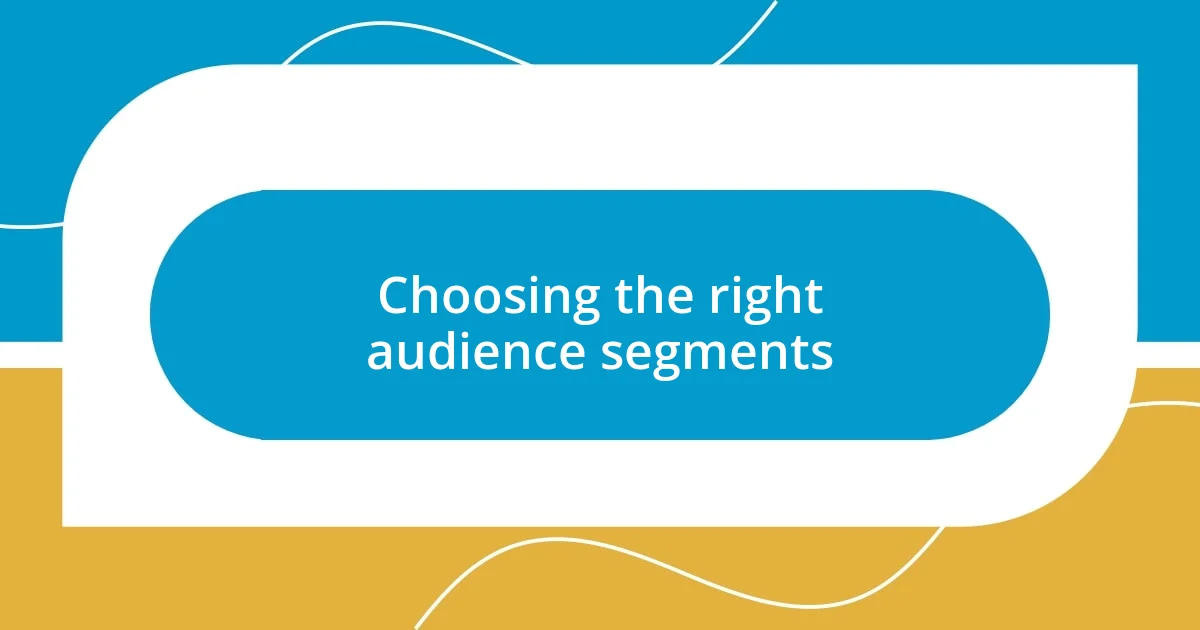
Choosing the right audience segments
Choosing the right audience segments is critical in ensuring that your remarketing efforts are both effective and efficient. From my viewpoint, it’s like assembling the right team for a project; you need people who understand the objective and know how to contribute meaningfully. For instance, I once targeted users who had abandoned their shopping carts. By focusing on this specific group, I could tailor my ads to remind them of their potential purchase, which drastically increased my conversion rates. These users are often more receptive because they’ve already shown interest, making them prime candidates for remarketing.
When selecting your audience segments, consider these key groups:
– Previous Customers: Engaging those who’ve already purchased can increase brand loyalty.
– Cart Abandoners: Targeting users who left items in their cart presents an opportunity to reclaim lost sales.
– Site Visitors: Remarketing to visitors who browsed your site helps rekindle interest in your offerings.
– Engaged Users: Focus on those who interacted with ads or emails but didn’t convert, as they’ve already displayed interest.
– Specific Demographics: Tailor your messaging based on age, location, or interests to create resonant ads.
By carefully choosing these segments, I learned to create a more personalized experience that resonates with the users, ultimately increasing the likelihood of conversion.
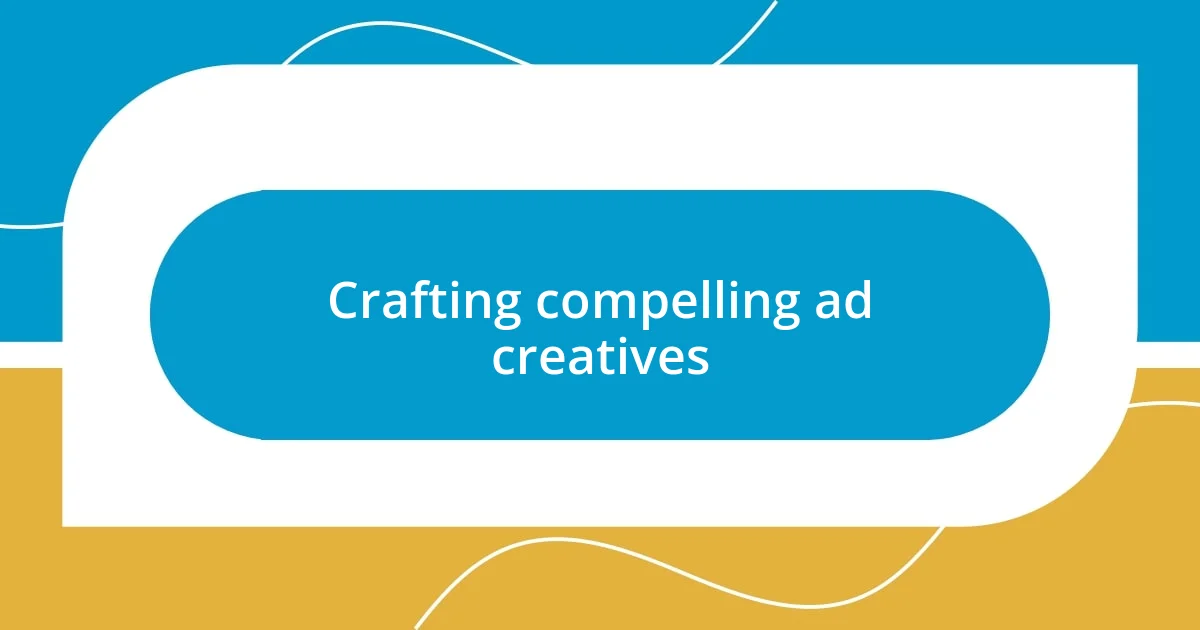
Crafting compelling ad creatives
Crafting compelling ad creatives has been a game changer for me in remarketing. I still remember the first time I created an ad that truly resonated – it had a simple yet powerful visual coupled with a strong call to action. The reception was incredible! It made me realize how crucial it is to not just show your product, but to weave a narrative that connects emotionally with the audience. Have you ever noticed how an engaging story can draw you in? That’s the kind of impact I strive for in every piece of creative.
One technique that worked wonders was incorporating user-generated content in my ads. When I featured testimonials or images from satisfied customers, it felt like a trusted friend was endorsing my brand rather than just a faceless advertisement. I could almost feel the shift in perception from potential customers; suddenly, my brand felt relatable and genuine. This connection not only increased engagement rates but also fostered a sense of community around my product.
I’ve also found that using dynamic ads has significantly boosted my effectiveness. These ads adapt their content based on user behavior, showcasing products that align with previous interactions. It feels personal, like each viewer is getting a tailored experience just for them. Remember the last time you saw an ad that felt like it was speaking directly to you? That’s the magic I aim for in my campaigns. It’s all about creating that moment of recognition and connection, which can ultimately lead to conversions.
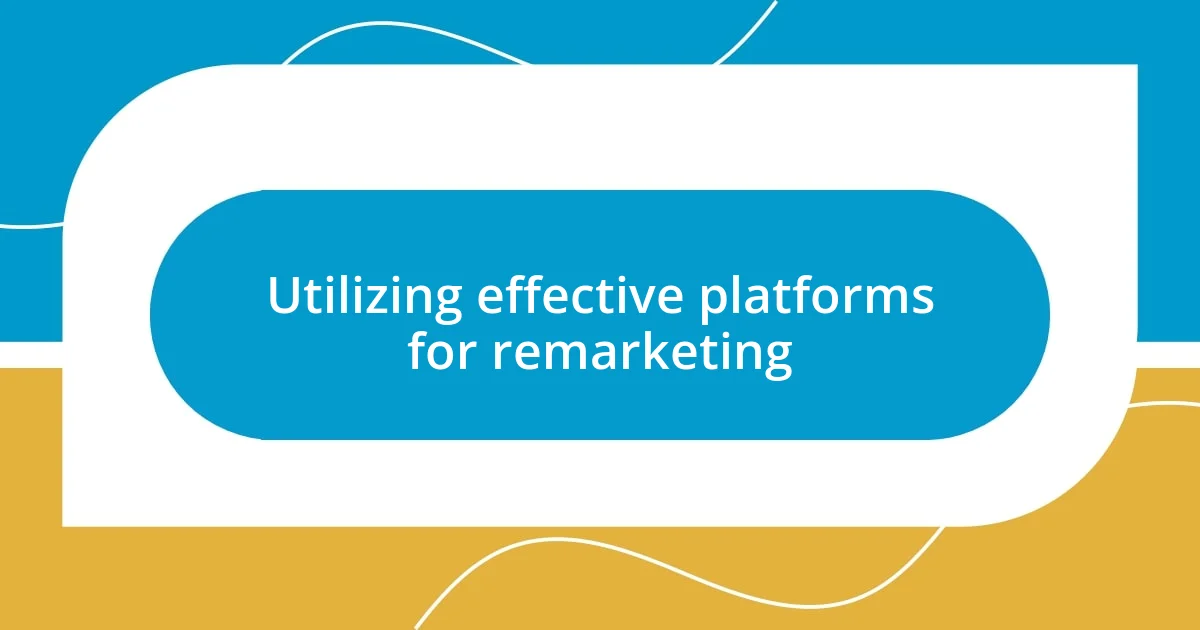
Utilizing effective platforms for remarketing
When it comes to utilizing effective platforms for remarketing, I’ve had the best results with Google Ads and Facebook Ads. Each platform has its unique strengths. For instance, I remember running a campaign on Google that utilized dynamic remarketing. Seeing how personalized the ads were, based on the products users had viewed, left me impressed. It felt like a friendly nudge, reminding potential customers of what they were interested in, and it substantially improved our click-through rates.
Facebook, on the other hand, offers a more visual and interactive experience. One of my favorite moments was when I used video ads targeting past visitors. There’s something about seeing product demonstrations that can reignite interest. When I analyzed the data afterward, the return on ad spend was noticeably higher, reinforcing my belief in capturing the audience’s attention through compelling visuals. Have you ever clicked on a video ad that just grabbed your attention? That’s the kind of hook I always aim to deliver.
Lastly, don’t underestimate the power of email platforms for remarketing. I’ve had great success sending tailored follow-up emails based on user behavior on my site. I vividly recall a time when a simple reminder email about an abandoned cart led to an unexpected spike in purchases. It’s about striking while the iron is hot and tapping into those moments of interest. How many times have you wished a brand would just send you a little nudge to remind you of a great deal? That’s the essence of effective remarketing.
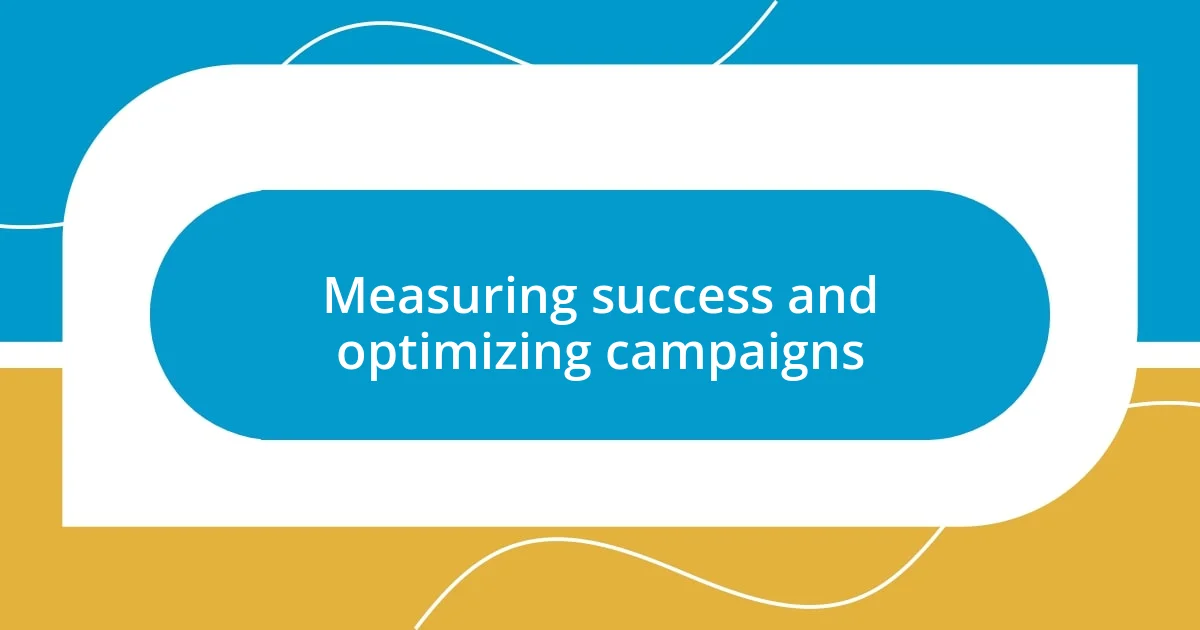
Measuring success and optimizing campaigns
Measuring the success of my remarketing campaigns became a pivotal aspect of my strategy. One moment stands out: I remember diving into the analytics after a campaign and seeing a jump in conversion rates that made my heart race. By leveraging metrics like click-through rates and return on ad spend, I could actually visualize how my efforts were paying off, and that was incredibly rewarding. It reminded me of the excitement of discovering a new favorite song that you just can’t stop playing.
Optimization is where the magic happens. I often reflect on the subtle changes I’ve made—like tweaking ad copy or adjusting targeting parameters—and how they led to significant improvements. For instance, when I replaced a generic call to action with a more personalized one, like “See why others love this,” the engagement skyrocketed. Have you ever wondered how a small shift in language could change someone’s perception? It’s those small, actionable insights that continually shape my campaigns and drive my results.
Another key lesson I learned is to embrace A/B testing. I once ran two variations of an ad in parallel, and the results were eye-opening. One ad highlighted a discount, while the other focused on the product’s unique features. I was astonished to find that while the discount ad drew more eyeballs, the feature-focused version drove higher conversions. It’s an ongoing journey to fine-tune my approach, and every test feels like an opportunity to learn something new. What have you discovered through testing? That exploration is where true optimization thrives.












